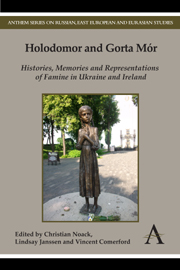Book contents
- Frontmatter
- Contents
- List of Figures
- Acknowledgements
- Introduction Holodomor and Gorta Mór: Histories, Memories and Representations of Famine in Ukraine and Ireland
- Part I Histories, Historiography and Politics
- Part II Public Commemoration
- Part III Trauma and Victimisation
- Chapter 8 Holodomor and the Politics of Memory in Ukraine after Independence
- Chapter 9 The Great Irish Famine in Stories for Children in the Closing Decades of the Twentieth Century
- Chapter 10 Collective Trauma in a Feature Film: Golod-33 as One-of-a-Kind
- Part IV New Sources and New Approaches to the Irish and Ukrainian Famines
- Index
Chapter 8 - Holodomor and the Politics of Memory in Ukraine after Independence
from Part III - Trauma and Victimisation
Published online by Cambridge University Press: 05 May 2013
- Frontmatter
- Contents
- List of Figures
- Acknowledgements
- Introduction Holodomor and Gorta Mór: Histories, Memories and Representations of Famine in Ukraine and Ireland
- Part I Histories, Historiography and Politics
- Part II Public Commemoration
- Part III Trauma and Victimisation
- Chapter 8 Holodomor and the Politics of Memory in Ukraine after Independence
- Chapter 9 The Great Irish Famine in Stories for Children in the Closing Decades of the Twentieth Century
- Chapter 10 Collective Trauma in a Feature Film: Golod-33 as One-of-a-Kind
- Part IV New Sources and New Approaches to the Irish and Ukrainian Famines
- Index
Summary
The 1932–33 Famine emerged as a topic in Ukrainian public and political discourse during the mid-1980s and formed part of an overall critique of the Soviet past. The usual set of stereotypical clichés about the Holodomor and their discursive representations read just about as follows:
During 1932 and 1933 the Ukrainian nation was subject to genocide. Under Stalin's leadership a famine was planned and executed by the ruling elite in Moscow with the aim of breaking the Ukrainian nation's possible resistance to the building of communism. The main target of this organised famine was the individualistic and freedom-loving Ukrainian peasantry, and with it the ‘backbone of the nation’ was broken. At the same time, the national intelligentsia likewise faced repression and the nation was effectively beheaded. Between 7 and 10 million people died from starvation (this is at least the number that ex-president Yushchenko and politicians used to quote; scholars are more cautious and prefer to speak about three and a half to four million victims of the Famine). The Famine struck the Ukrainian nation and its genetic potential beyond remedy, and the consequences of this blow are felt to the present day.
- Type
- Chapter
- Information
- Holodomor and Gorta MórHistories, Memories and Representations of Famine in Ukraine and Ireland, pp. 167 - 188Publisher: Anthem PressPrint publication year: 2012
- 3
- Cited by



